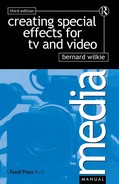Scenic Projection
This is the system where large photographic backgrounds are projected on a screen behind the action. It is cheap, easy to use and enables very realistic indoor or outdoor scenes to be re-created in the studio.
It can be employed in both movie and TV studios and can provide moving as well as static backgrounds.
When moving subjects are required, the recording camera and the projector must be interlocked to ensure that the shutter of the camera is synchronised with the shutter of the projector.
Back projection
This is the oldest and most widely used form of projection, but demands more studio space than other systems. The projector is situated behind a transluscent screen which itself is placed behind the studio scene. A very powerful projector is required because the screen absorbs a great deal of the illumination. To obtain maximum benefit from the available light the camera should be positioned on the same axis as the projector.
Smaller set-ups are used to obtain the moving scenes in the rear windows of cars in the studio.
Front-axial projection
This is more economical in the use of space as the projector is positioned in front of the screen which can therefore be placed at the rear of the studio.
The screen, consisting of a flexible material covered with millions of tiny glass beads has the unique property of being able to reflect the light that strikes it back along the path from which it came.
This of course implies that all the light is reflected back to the projector. To make the system work it is necessary to install a beam-splitter between the projector and the recording camera so that some of the light returning from the screen is diverted to the camera. The screen material reflects so efficiently that a domestic 35mm slide projector can be used to provide large background scenes, while light reflected from actors in the projector beam is insufficient to affect the film.
Application
Front-axial screen material can be cut up and used to provide multiplane layouts. For instance a projected picture of a house against sky could be split into two parts, the house being beamed on to a profiled cut-out and the sky on to the studio backing. A person walking from behind the cut-out would appear to come from behind the house. Useful for Lilliputian scenes where small people walk around large objects.

1. Back projection
Easy to set up and use, back projection requires a lot of studio space. Large mirrors are used to reduce the distance from projector to screen. a, Mirror, b, Translucent screen, c, Camera, d, Stage, e, Movie projector.
2. Front-axial projection
More care is needed in setting up, but front axial projection uses no extra studio space and provides brighter pictures. It also permits the background picture to be split up into layers if profiled pieces of reflex screen material are positioned in front of the action, a, Reflex screen, b, Camera, c, Semi-transparent mirror, d, Projector, e, Black backing, f, Free standing profiled screen faced with reflex material.
